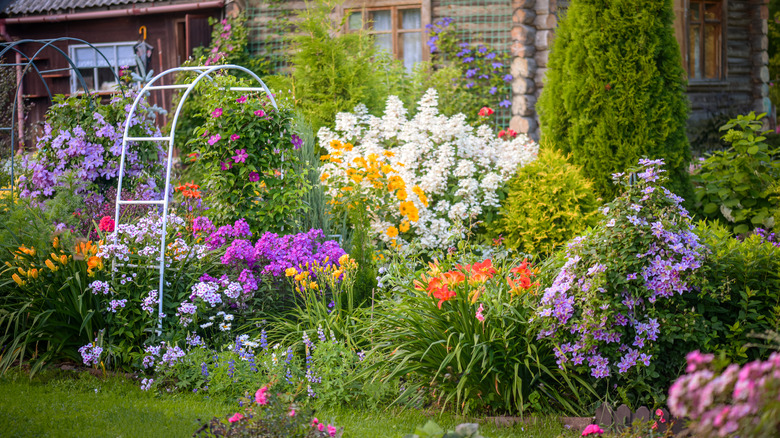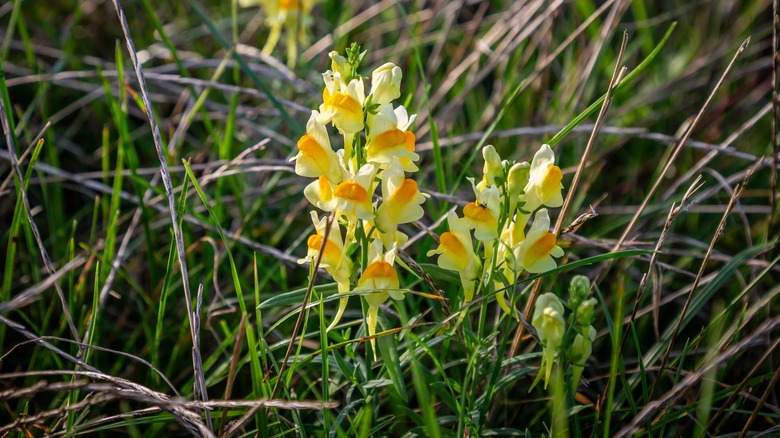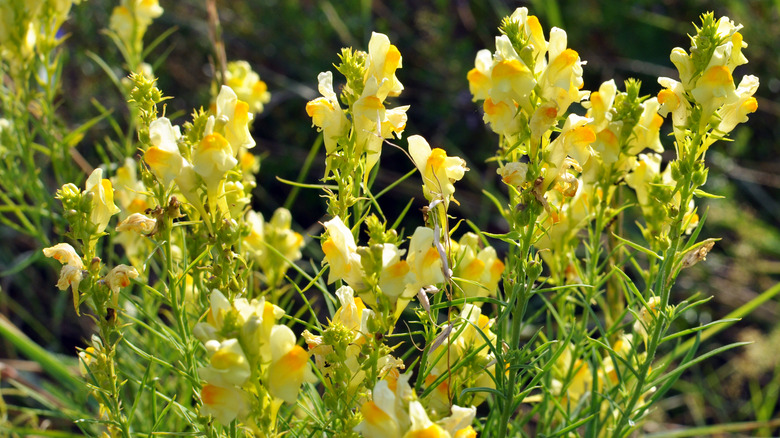The Invasive Weed That Resembles Snapdragons But Will Take Over Your Yard
Decor and accessory dupes can save you money without losing their aesthetic. Yet, like ladybugs and their nasty twin Asian lady beetles, invasive weeds playing dress-up as ordinary flowers can be the worst kind of dupe. That's true for yellow toadflax, which, at first glance, looks like a snapdragon — with a penchant for snapping up your yard space. You don't want to mistake these deceiving invasive weeds for flowers.
Also known as wild snapdragons (go figure), these weeds are highly invasive. That's because they can sprout so many other plants in a cycle. "A single plant produces over 100 shoots during vegetation, from rhizomes forming a dense carpet of yellow toadflax," Dr. Ivo Toševski told the National Invasive Species Information Center. "Each stem can produce up to 30 seed capsules, with each capsule yielding up to 250 seeds. Thus, one stem can produce over 7,500 seeds per stem or over 20,000 seeds per single plant."
These flowery invaders are a concern for homeowners in practically every state except Mississippi and Florida, which have zero reports to the Early Detection and Distribution Mapping System (EDDMapS). EDDMapS also indicates that these toadflax are especially problematic in Colorado, Idaho, and Montana, which have the highest report numbers.
How do toadflax get into yards?
Unless you intentionally plant yellow toadflax or its equally noxious cousin, Dalmatian toadflax, it appears in your yard by accident. Carried on shoes, thrown around by vehicles, or distributed through the air, its seeded ability to travel is how it has become so invasive. One way to keep these little menaces out of your yard is to always check yourself and your equipment, like bikes, over carefully after being out in nature.
Though a study at the University of Massachusetts Amherst discovered that the spread of 80% of Invasive species is linked to plant nurseries. So it's important to stay vigilant in looking for these plants — especially since it's easy for invasive species to yard hop and bother your neighbors.
Once yellow toadflax settles into your yard, it can wreak havoc. Not only will it push out other, often native, plants, including grasses, but it can also lead to soil erosion and surface runoff. It is when the weather and the ground start to warm up in early spring that yellow toadflax starts rearing its deceptively pretty head.
How to get rid of yellow toadflax
Toadflax is a terrific example of an invasive weed. Why? Because it has evolved with tactics to stay alive — and persistent. Not only does it spread like, well, wildfire, but its massive root system makes it difficult to get rid of once it shows up. Removing entire plant and root systems by hand for smaller outbreaks of the weed can get rid of yellow toadflax. Though that's only for a small number of plants even with this common kitchen item that makes it easier.
When you notice an established patch of yellow toadflax, you can mow it down to reduce its spread and seed production and then treat the area. Be warned, though, that toadflax has evolved to resist many herbicides. This resistance means that herbicides often need to be reapplied for years to keep the plant from cropping up again. Bio-control with insects is also an option, though there hasn't been enough research done to indicate how helpful they are in mitigating toadflax growth.
Keeping the invasive toadflax(es) out of your yard or garden is the best way to protect your space. Removal is a difficult process, so prevention is a better plan to move forward, especially if you live in states where these plants primarily thrive.


